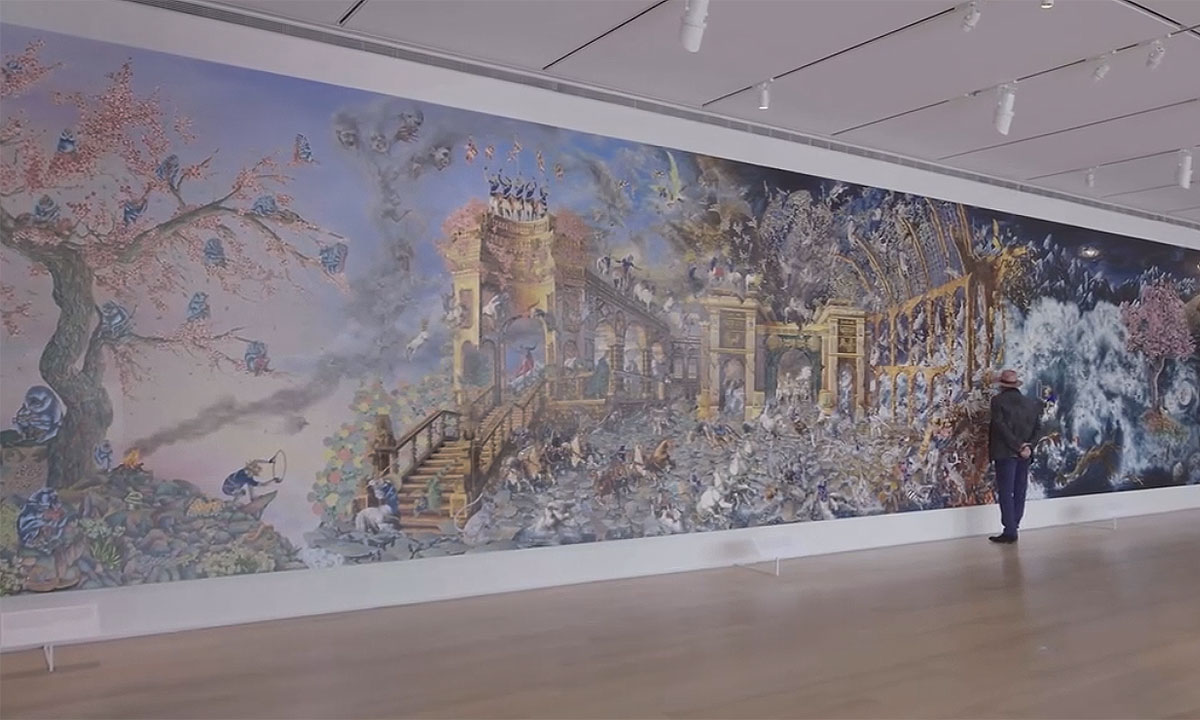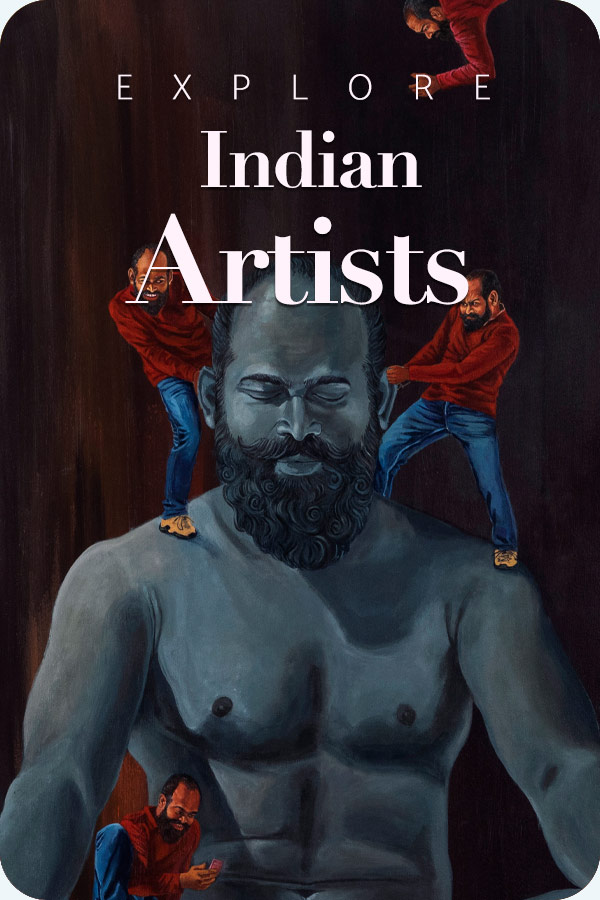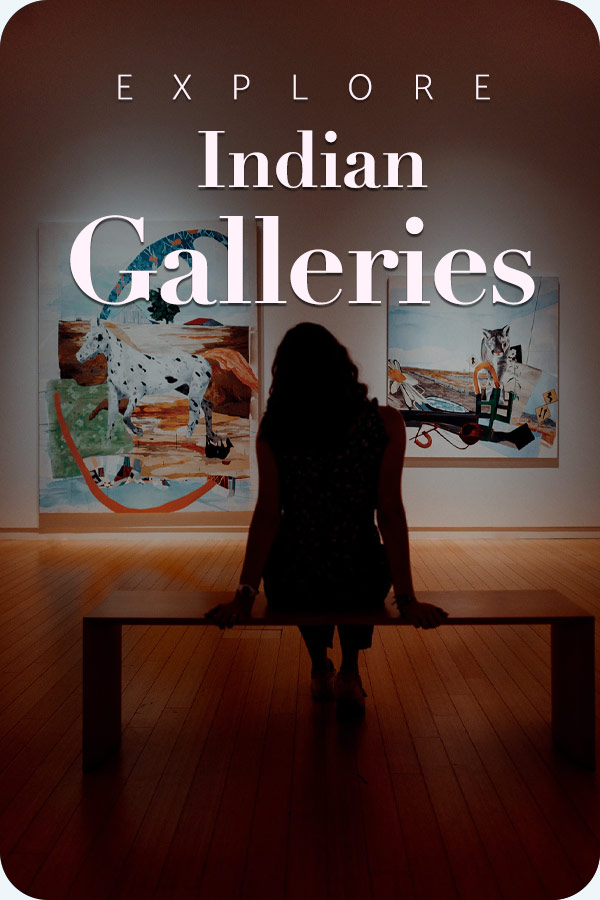
Above: A piece of Raqib Shaw’s colossal ‘Paradise Lost’ (2009–25) displayed at the Art Institute of Chicago. Each of the 21 canvases (cumulatively over 100 feet long) is coated with enamel, glitter, and gemstones. The exhibition will continue till January 19, 2026. The 21-panel artwork vividly recounts Shaw’s life from Kashmir to the West. As Art Institute curator Madhuvanti Ghose observed, visitors are “stacked in front of it… it’s really a community viewing of people looking at Paradise Lost – it’s really something”.
Paradise Lost: An Epic Unveiled
View this post on Instagram
The global art world is buzzing with a fresh frame unlike any other, with Raqib Shaw’s Paradise Lost, now displayed at the Art Institute of Chicago. The 100-foot-long masterpiece, composed of 21 dazzling panels, is the first complete presentation of Shaw’s chef d’oeuvre. Born in Calcutta and raised in Kashmir, Shaw’s story is a reverberation of exile, separation, and reclamation of life through a single medium- ‘art’. Later, after a conflict in 1989, Raqib shifted to London and carried on his life there, much like how the Indian folk art projects collective memory, Shaw’s artwork depicts an amalgamation of transitions ranging from personal loss to cherishment. Visitors burying their feet at the museum’s Gallery 141 are received by a panoramic view: colourful canopies, surfaces smeared with glittering rhinestones, and mythical figures latching on across 100 feet of canvas. The spectators linger for hours, investigating hidden details and implied objectives of the pieces.
A Kashmiri Childhood in Paint
Numerous panels are bridged as Shaw’s memoir of Kashmir— the snow-capped mountains, clear illuminated skies, and solitary figures yowling in separation and exile. In the canvas, Birds escape their cages, serpents coiling in intimidation, and empty huts signify the long-lost sod. Shaw expatiates on the Art Institute’s website: “It is a story of the many paradises we inevitably lose as we move through life: the paradise of childhood… of belonging… of mental stillness.” This is not a trivial transition into nostalgia, but an allegory of losing a place called ‘HOME’.
The themes of Paradise Lost are crafted to percolate deep into one’s soul. In Shaw’s view, Human beings are vectors of loss, and it is exponentially shown through highlighting the “innocence of childhood”. He explains that “not beauty as ornament but as necessity”: art “has the power to transform sorrow into meaning… to alchemize personal pain into something luminous and enduring.” Shaw hopes his work will compel the viewers to slyly take a pause and “look carefully and… feel without haste,” providing “a space of reflection for emotional recognition”.
Technique as Spectacle
Every unit of Paradise Lost is scrupulously handcrafted. Shaw used porcupine quills, syringes, and imbued the golden panels with automotive enamel paint; later bejewelled them with glittering stones. The paintings are essentially designed to engage the viewers, as it turns out to be a task of treasure hunt for them to trace hidden monkeys, jewelled birds, and tiny human faces. CBS Chicago noted that “every inch was created with automobile paint… dense with tiny details like faces in the waves of the ocean.” All these add up and unleash an overwhelming cinematic perception that almost feels unreal to the naked eye.
Shaw’s Own Words
In a recent video aired by the Art Institute, Shaw mentioned Paradise Lost as “a cinematic canvas that spans decades of my life, but also belongs to everyone who has ever lost something precious.” In this age of AI-generated instant images and short attention spans, Shaw cordially invites a meditative pause, crafting not only an artistic masterpiece but also a space where people can find themselves. Though his painting borrows from Milton’s epic, although not a direct retelling, Shaw brings it to the centre as a shared metaphor, as a reflection of many lives, known and unknown, and makes a strong appeal to the diasporic audience and younger generations alike. This is a tribute to the millions of lives vulnerable inducted into the vicious cycle of exodus, separation, and losing everything to man-made chaos.
Paradise Lost (2009–25) – Key Facts:
| Details | Description |
|---|---|
| Artist | Raqib Shaw (b. 1974, Calcutta; raised in Kashmir) |
| Medium | Acrylic liner, enamel paint, glitter, and inlaid stones on panel |
| Size | 21 panels, totaling approximately 100 feet (30 meters) in width |
| Content | Four narrative chapters of Shaw’s life – childhood in Kashmir, exile, struggle, and a rejuvenating metamorphosis |
| Exhibition | Art Institute of Chicago (Galleries 141–42), June 7, 2025 – January 19, 2026 |
| Curator | Madhuvanti Ghose – an expert in Asian art, supported by patrons Usha and Lakshmi Mittal |
For students of art and new age creators, Shaw’s work offers unparalleled inspiration. The painting’s narrative, enriched in metaphor and drama, makes the spectators “disappear” into its ambit, yet leaving enough room for the viewer’s conscience to trace a new element almost every minute. The paintings celebrate life in a bit unconventional manner, making it an event in itself. It is a reminder that even in loss and exile, there is beauty and meaning to be found – it’s all about perceptions.







